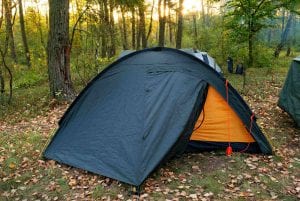Spending the night in a wet down sleeping bag is a special kind of purgatory. Soaking wet down filaments clump together like soggy toilet paper, and the insulating qualities plummet — which can be a big deal when you’re sleeping wild on a cold night.
Generally speaking, there are three things that get a sleeping bag wet — rain, dew, and body moisture. If you want to know how to keep a down sleeping bag dry, you must take steps against all three.
- Some down sleeping bags use water-resistant insulation and shell fabrics. They’re often more expensive, but it might be worth the extra layout.
- Use dry-bags, rucksack covers, and good packing techniques to keep the sleeping bag dry while it’s in your backpack.
- Site your tent properly, make sure it’s dry inside, and manage wet gear to make sure it doesn’t soak your sleeping bag.
- Tweak your sleep system with liners and covers to combat dew and body vapor.
This guide is about keeping a sleeping bag dry, but you could also check out our guide on what to do if your sleeping bag gets wet.
How To Keep a Down Sleeping Bag Dry by Picking the Right Sleeping Bag
Gear brands have invested vast amounts of research in refining sleeping bag design and developing new materials.
These days the best down sleeping bags offer impressive levels of water-resistance — and while they’re certainly not cheap compared to synthetic bags, they might just be worth your hard-earned cash.
Water-Resistant Down
Not all down is created equal, and many sleeping bag manufacturers now treat their down fill with water-resistant substances — usually wax, silicon, or perfluorinated compounds (PFCs).
Treated down insulation has lots of different brand names, but commonly used ones include “Hydrophobic Down,” “Dridown,” or “Ultra-Dry Down.” Performance varies, but these bags will usually absorb less moisture, insulate more effectively when wet, and dry more quickly.
Water-Resistant Shell Fabrics
Many gear manufacturers also use water-resistant materials for the outer shell of the sleeping bag. They may use a durable water repellent (DWR) coated fabric, or sometimes a water-resistant breathable membrane.
In fact, some manufacturers argue that you don’t need to use water-resistant down insulation if your shell material is good enough.
Fine-Tune Your Packing System
Your sleeping bag is arguably at its most vulnerable when it’s in your backpack. A good soaking on the trail, and you’ll be unpacking a sleeping bag that’s next-to-useless.
The thing is, most packs aren’t very waterproof — so you need to devise a belt-and-braces approach to keep the rain out.
Use a Backpack Cover or Liner
Which of these you pick is just a matter of preference, but using both is probably overkill.
- A backpack cover can be deployed and removed as the weather changes. Water can sometimes still seep into the bag through the back panel, plus they can be unwieldy in high winds.
- A waterproof rucksack liner can be more secure, but it makes it much more difficult to access your gear. If you want to get at something near the bottom, you have to unpack the whole bag.
Protect the Sleeping Bag Itself
As any seasoned hiker will tell you, vulnerable bits of kit should always be kept in their own individual dry-bags. And it doesn’t come much more vulnerable than your sleeping bag.
This is not the time to deploy the cheap bulk-buy dry-bag, or the scuffed five-year veteran. Blow it up, seal it, squeeze it — if the air can get out then the rain can get in.
Some campers even recommend lining your sleeping bag’s compression sack with a lightweight trash bag — in addition to putting the whole thing in a dry-bag. We haven’t done this ourselves, but we reckon it can’t hurt.
Don’t Put it at the Bottom of Your Pack
Received wisdom is that your sleeping bag should go at the bottom of your pack. Based on hard experience, we humbly disagree.
You see, rainwater has a habit of pooling at the bottom of a rucksack, particularly if you’re using a waterproof cover. If your sleeping bag is sat in water for hours, it only takes one tiny flaw in the dry-bag and those down filaments will start wicking up the wetness like a thirsty thru-hiker with a bottle of cold beer.
Instead, we’d suggest you put it near the bottom of your bag, but create a little buffer zone with something like your air mattress that won’t suffer quite so badly if it gets wet.
Manage Wet Gear
However well you think you’ve protected the sleeping bag with dry-bags. It’s not a good idea to stash it next to a wet tent or a soaked rain jacket. Put these items in their own waterproof bags, use external stash pockets, or lash them to the outside of your pack if you prefer.
Practice Meticulous Campcraft
When it comes to camping in the rain, where you site your tent and how you manage your wet and dry gear is crucial.
Site Your Tent Properly
It sounds obvious, but pitch your tent on the driest ground you can. Shelter it from the worst of the wind if possible, but remember that hollows can sometimes turn to marsh in prolonged rain.
Make Sure the Tent is Dry Inside
If you’ve put your tent away wet — or if it’s been tied on the outside of your pack during a storm — chances are it’s going to be pretty wet.
Resist the temptation to dive straight into it and unpack all your dry gear. Instead, take the time to mop it out and get it real dry inside. We carry a spare travel towel for this very purpose. You might need to wring the towel out a couple times, but in wet weather, your body heat alone won’t be enough to dry the inside of a tent.
Ventilate the Tent
One of the main things that’ll get your sleeping bag wet once it’s in the tent is dew.
A tent is a humid environment, especially in wet weather, and the dampness in the air will condense on the outside of the bag, eventually soaking through and wetting it.
The best way to protect against this is to ventilate the tent as much as you can — even in cooler conditions. Most tents will have ventilation flaps that you can open up, and many also have mesh door-flaps that can improve air-flow in milder conditions while still keeping the bugs out.
Quarantine Wet Gear
The last thing you want to do is heap up all your wet clothes right next to your sleeping bag. Keep them in the porch if you have one, or designate a “wet” corner of the tent — well away from your sleeping area.
Adjust Your Sleep System
When it comes to sleep systems, one size does not fit all — and that goes for both people and conditions.
If it’s wet or cold out, there are a few adjustments you can make to keep your sleeping bag dry.
Dry Your Sleep Mat
If you’ve had your air mattress at the bottom of your pack or tied on the outside of it in the rain, chances are it might be wet. Just as you did with your tent, use a pack towel to get it as dry as you can before you lay your sleeping bag on it.
Don’t Breathe Inside the Bag
On cold nights, it’s tempting to put your face inside your sleeping bag. This keeps your nose from turning into an icicle, and your breath feels like a fan heater inside the bag.
Except that there’s a lot of moisture in your breath. Keep your head in your sleeping bag for too long and it’ll start to get wet from the inside-out.
Instead, use a scarf or neck-gaiter around your face, and keep your nose and mouth out of your sleeping bag.
Consider a Liner
A lightweight silk or cotton sleeping bag liner can prevent some of the moisture from your body making it through into the down fill.
You may also have heard some chatter online about “VBLs.” A VBL is a vapor barrier liner, and these are quite different to a standard liner because they’re not breathable. In fact, that’s the whole point. A VBL will stop any of the moisture from your body getting through into the sleeping bag — which means that the insulation stays drier.
Of course it also means that you marinate in your own sweat, so these liners are only really useful for winter camps when you’re going to be sleeping pretty cold.
Consider a Cover
Some experienced campers swear by putting a cheap synthetic sleeping bag over the outside of the sleeping bag. Others recommend a light fleece blanket.
Either way, the reason for this is to protect the down sleeping bag underneath from dew and condensation. We’ve never needed to do this ourselves, but if ventilating the tent is tricky for whatever reason, it could be a good option.
Protect the Footbox and Hood
The head and foot of the sleeping bag are the parts most likely to touch the tent — and thus those most likely to get wet. Of course, the ideal solution is to buy a tent that’s long enough for your body, but in a pinch you can use a plastic sack, rain jacket, or backpack as a barrier.
Don’t Wipe Down the Dew Drops on the Bag
You see the way the dew beads into little droplets on the outside of the sleeping bag? That’s the water-repellent shell material doing its job. Smearing them across the surface of the fabric just means the moisture is more likely to soak through into the down fill.
Dry Out if You Can
In rainy, humid conditions, it’s kind of inevitable that your sleeping bag will get a little damp. What to do about it will depend on how big the problem is.
Take Opportunities to Air the Bag
A small amount of damp isn’t usually a problem. Down will still insulate reasonably well until it starts to get properly wet, and your body heat should help dry it out a little.
It’s still worth trying to air the bag whenever you can. If you have a dry spell with a bit of warmth, get your sleeping bag out and let the sunshine get to it. And if you end up spending a night indoors, always unpack the bag and give it an airing.
Plan for “Dry-Out” Days
Sometimes, you have to accept you’re on a losing streak. In prolonged wet weather, you’ll really struggle to dry your sleeping bag out once it gets properly wet.
In these circumstances, you need to try for a reset. Whether it’s a cabin, a mountain lodge, a motel, or whatever — if you can get somewhere with heating or even just a woodburner then you can get your gear dried out. It’s pretty much always worth the time and expense, and you’ll be back on the trail before you know it.
Read more about this in our guide to what happens when your sleeping bag gets wet.
FAQs
Is a Down Sleeping Bag Ruined if It Gets Wet?
Not at all, but the insulation may not work well when wet, and it can be very difficult to get a down sleeping bag dried out once it’s wet.
Can You Air-Dry a Down Sleeping Bag?
You can, and normally this is how you would get it dry on the trail. However, it can take a long time.
How Do You Keep a Sleeping Bag Dry?
You need to protect your sleeping bag from rain, dew, and body vapor, both in the tent and while it’s on your back during the day.






